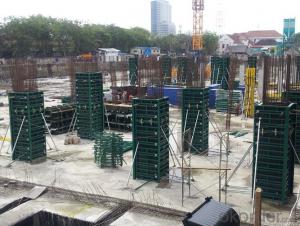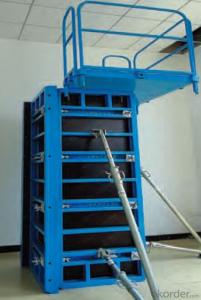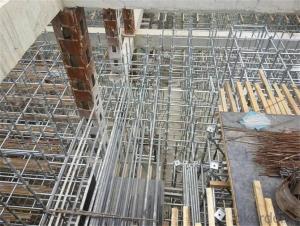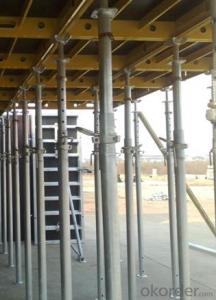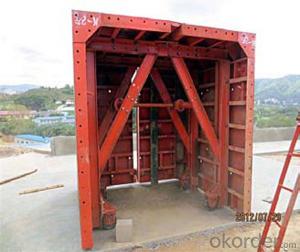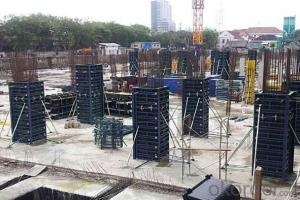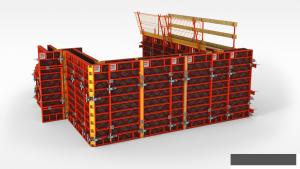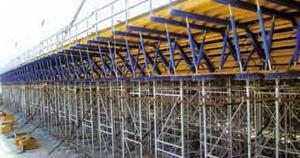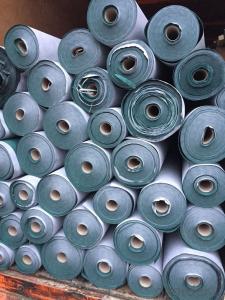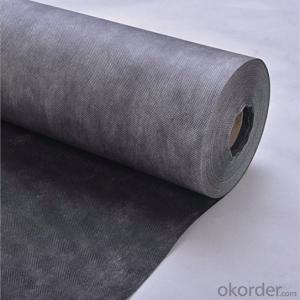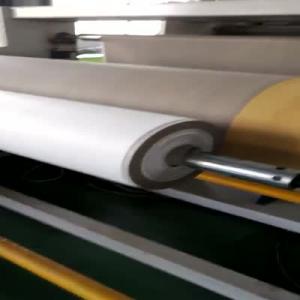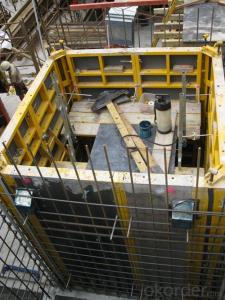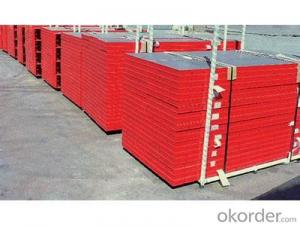120 STEEL FRAME FORMWORK FOR CONSTRUCTIONS
- Loading Port:
- Shanghai
- Payment Terms:
- TT OR LC
- Min Order Qty:
- 1000 m²
- Supply Capability:
- 100000 m²/month
OKorder Service Pledge
OKorder Financial Service
You Might Also Like
1. Structure of 120 Steel Framed Formwork Description
Single-side bracket is a kind of formwork for the concrete pouring of single-side wall. The construction is easy and fast. The components have good standard performance and versatility. The pouring height is adjustable, the maximum height of a single pouring is 8.9m.The formwork is always used in the concrete pouring of basement, subway, Sewage treatment factory and so on. The waterproof of the finished wall is excellent
2. Main Features of 120 Steel Framed Formwork
-easy to assemble
-simple structure.
-and convenient for transportation
-convenient for storage.
3. 120 Steel Framed Formwork Images
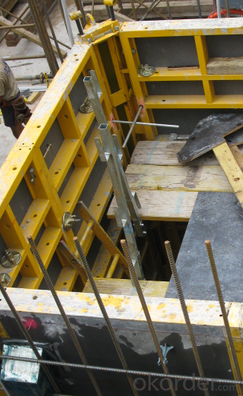
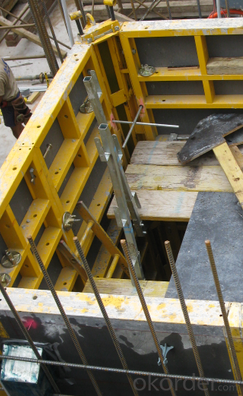
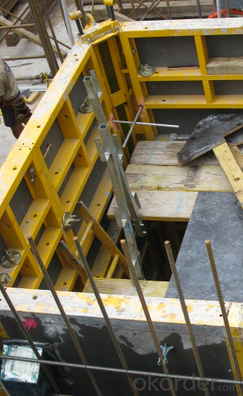
4. Single-side Steel Framed Formwork Specifications
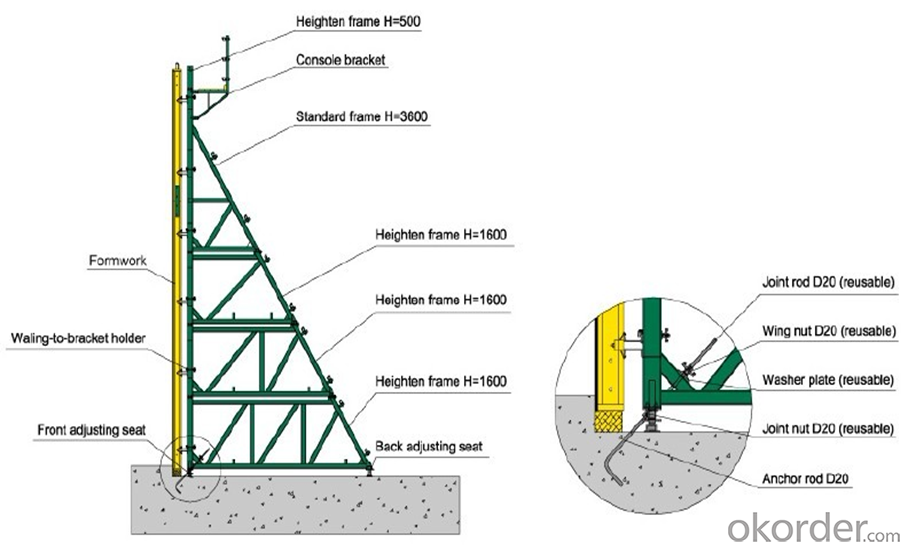
5.FAQ of 120 Steel Framed Formwork
1) What can we do for you?
.We can ensure the quality of the 120 steel framed formwork and avoid extra expenses for customers.
.We can provide you the professional technical team.
.We can provide professional building proposal for your project.
. Please feel free to customize.
2) What promises can be done by us?
. If interested in single side steel framed formwork, please feel free to write us for any QUOTE.
. If need any technical and building assistance, we could provide on-site professional staff for instruction.
. Please DO check goods when courier knocks your door and contact us asap if any issueS.
3) What about of our after-sale service?
. Response will be carried out in 24hours after receiving any complain or request.
. Single side steel framed formwork cost can be refund after order is confirmed.
. If the products are not based on the requirements, there will be the relevant compensations made for you.
4) What about the package and shipping time?
.Packing: wood package and
.Shipping: by sea
Shipping time: Normally small orders, it just1week business days to arrive your hand; When comes to the customs declaration, it may need 2 weeks.
- Q:How does steel frame formwork prevent the formation of concrete segregation during pouring?
- Steel frame formwork prevents the formation of concrete segregation during pouring through its strong and rigid structure. The steel frame formwork is designed to securely hold the concrete in place, preventing any movement or separation of the aggregate particles from the cement paste. Firstly, the steel frame formwork provides stability and prevents any deformation or bulging of the formwork during the pouring process. This ensures that the concrete is poured evenly and uniformly, without any gaps or voids that could lead to segregation. Additionally, the steel frame formwork is typically lined with plywood or other materials that have a smooth surface. This smooth surface helps to reduce friction between the formwork and the concrete, allowing for a more consistent and uniform flow of the concrete. This reduces the likelihood of aggregate particles settling or segregating from the cement paste. Furthermore, the steel frame formwork is designed to have tight joints and connections, preventing any leakage or seepage of the concrete during pouring. This prevents the excess water or cement paste from escaping, which could cause the aggregate particles to settle at the bottom and lead to segregation. Overall, the strong and rigid structure of steel frame formwork, along with its smooth surface and tight joints, ensures that the concrete is poured and contained properly. This helps to prevent the formation of concrete segregation by promoting a homogeneous mixture of cement, aggregate, and water throughout the pouring process.
- Q:How does steel frame formwork help in achieving consistent concrete quality?
- A construction technique called steel frame formwork utilizes steel frames to support temporary molds or formwork for pouring concrete. This approach offers several advantages, including the achievement of consistent concrete quality. To begin with, steel frame formwork surpasses traditional timber formwork in terms of stability and rigidity. The steel frames are designed to withstand the pressure exerted by wet concrete, effectively maintaining the shape and preventing any deformation or warping during the pouring process. This stability eliminates the possibility of uneven surfaces or irregularities in the concrete, thus contributing to a more uniform concrete quality. In addition, the precise alignment and positioning of the steel frame formwork are crucial for achieving consistent concrete quality. The steel frames are manufactured with high precision, allowing for accurate placement and alignment of the formwork. This level of accuracy ensures that the concrete is poured in the desired shape and dimensions, resulting in a consistent and uniform finish. Moreover, steel frame formwork provides a smooth and even surface for the concrete. The steel frames are typically coated or treated to prevent adhesion between the steel and concrete, making it easy to remove the formwork after the concrete has cured. This smooth surface helps minimize surface defects and imperfections, enhancing the overall quality and appearance of the concrete. Furthermore, steel frame formwork allows for efficient and controlled pouring of concrete. The formwork is designed with adequate openings and access points for the placement of reinforcement bars and pouring of concrete. This controlled pouring process ensures even distribution of the concrete, eliminating the risk of voids or weak spots in the structure. Overall, steel frame formwork is a highly dependable and efficient method for achieving consistent concrete quality. Its stability, precise alignment, smooth surface, and controlled pouring capabilities all contribute to a uniform and high-quality finish. By utilizing steel frame formwork, construction projects can minimize variations in concrete quality, resulting in stronger and more durable structures.
- Q:Can steel frame formwork be used for both suspended and supported slab construction?
- Yes, steel frame formwork can be used for both suspended and supported slab construction. The steel frame provides the necessary strength and stability to support the weight and loads of the slab, regardless of whether it is suspended or supported. Additionally, steel formwork is versatile and can be easily adjusted and reused for various construction projects.
- Q:How does steel frame formwork handle different types of cured concrete removal techniques?
- Steel frame formwork is designed to handle different types of cured concrete removal techniques effectively. The strong and durable steel frame provides stability and support during the removal process, ensuring that the formwork structure remains intact. Whether it involves using mechanical methods like jackhammers or chemical solutions for concrete dissolution, the steel frame formwork can withstand the forces and pressure exerted during the removal without compromising its structural integrity. Thus, steel frame formwork is well-equipped to handle various techniques for removing cured concrete efficiently and safely.
- Q:What is the lifespan of a steel frame formwork system?
- The lifespan of a steel frame formwork system can vary depending on several factors. Generally, a well-maintained and properly used steel frame formwork system can last for several years, typically around 10 to 20 years. However, it is important to note that the lifespan can be influenced by various factors such as the quality of materials used, the frequency of use, the extent of maintenance and repairs, and the nature of the construction projects it is used for. Regular inspections and maintenance are crucial to extend the lifespan of the formwork system. This includes checking for any signs of wear and tear, corrosion, or damage, and promptly addressing any issues that arise. Proper cleaning, lubrication, and storage also play a significant role in preserving the lifespan of the steel frame formwork system. Additionally, the type of construction projects it is used for can impact its lifespan. Heavy-duty projects with frequent use and rough handling may result in faster wear and tear compared to lighter projects with less frequent use. In conclusion, the lifespan of a steel frame formwork system can range from 10 to 20 years, but this can vary depending on factors such as maintenance, quality of materials, frequency of use, and construction project type.
- Q:What are the different methods of fixing and anchoring steel frame formwork?
- There are several different methods of fixing and anchoring steel frame formwork, depending on the specific requirements of the construction project. One common method is the use of adjustable clamps or fasteners to secure the formwork to the supporting structure. These clamps can be easily adjusted to accommodate different sizes and shapes of formwork panels, allowing for flexibility in the construction process. Another method is the use of tie rods or threaded bars to anchor the formwork. These rods or bars are inserted through the formwork panels and secured with nuts or washers on both ends. This provides a strong and stable anchor point for the formwork, ensuring that it remains in place during the concrete pouring process. In some cases, steel formwork may also be fixed and anchored using welding techniques. This involves welding the formwork panels directly to the supporting structure, creating a permanent and secure attachment. However, welding may not be suitable for all projects, as it requires specialized equipment and expertise. Additionally, in situations where the formwork needs to be supported from below, props or shores can be used. These props are typically adjustable in height, allowing for easy adjustment and leveling of the formwork. They provide additional support and stability, preventing any movement or sagging of the formwork during the concrete pouring process. Overall, the choice of fixing and anchoring method for steel frame formwork depends on factors such as the size and complexity of the structure, the duration of the construction project, and the specific requirements of the formwork design. It is important to consult with structural engineers and construction professionals to determine the most appropriate method for each individual project.
- Q:Can steel frame formwork be used in seismic zones?
- Yes, steel frame formwork can be used in seismic zones. Steel is known for its strength and durability, making it suitable for construction in areas prone to earthquakes. It provides the necessary stability and resistance required to withstand seismic forces, ensuring the safety and integrity of the structure.
- Q:Can steel frame formwork be used for concrete beams?
- Yes, steel frame formwork can be used for concrete beams. Steel frame formwork provides a strong and durable support structure for pouring and curing concrete beams, ensuring accuracy and stability during the construction process.
- Q:How does steel frame formwork impact labor requirements?
- Steel frame formwork can have a significant impact on labor requirements in construction projects. One of the key advantages of steel frame formwork is its durability and reusability. Unlike traditional wooden formwork, steel frame formwork can be used multiple times, reducing the need for frequent replacement and thus reducing the labor required for formwork installation and removal. Additionally, steel frame formwork is lightweight and easy to handle, which makes it easier for laborers to assemble and disassemble. This not only saves time but also reduces the physical strain on workers, ultimately improving their productivity and reducing the risk of fatigue-related accidents. Moreover, steel frame formwork offers greater flexibility and precision in shaping concrete structures, allowing for more efficient and accurate construction. This accuracy reduces the need for manual adjustments, resulting in fewer errors and rework, thereby saving labor time and costs. Furthermore, steel frame formwork is known for its quick assembly and disassembly process. The standardized components can be easily interlocked, reducing the time and effort required for formwork installation and removal. This efficiency leads to faster construction progress and shorter project durations, ultimately reducing labor requirements. Overall, the use of steel frame formwork in construction projects positively impacts labor requirements by reducing the need for frequent replacements, enhancing worker productivity, minimizing errors, and facilitating quick assembly and disassembly.
- Q:Can steel frame formwork be used for both small and large scale construction projects?
- Both small and large scale construction projects can make use of steel frame formwork. These systems are extremely versatile and can be easily adjusted and customized to accommodate projects of varying sizes and complexities. They possess excellent strength and durability, making them suitable for large-scale projects that require heavy loads and high levels of stability. Furthermore, steel frame formwork ensures precise and accurate results, guaranteeing the construction of consistent and high-quality structures. The modular nature of steel formwork allows for effortless assembly and disassembly, making it efficient for use in both small and large scale projects. In conclusion, steel frame formwork is a dependable and flexible solution that can be tailored to meet the requirements of any construction project, regardless of its size.
1. Manufacturer Overview |
|
|---|---|
| Location | |
| Year Established | |
| Annual Output Value | |
| Main Markets | |
| Company Certifications | |
2. Manufacturer Certificates |
|
|---|---|
| a) Certification Name | |
| Range | |
| Reference | |
| Validity Period | |
3. Manufacturer Capability |
|
|---|---|
| a)Trade Capacity | |
| Nearest Port | |
| Export Percentage | |
| No.of Employees in Trade Department | |
| Language Spoken: | |
| b)Factory Information | |
| Factory Size: | |
| No. of Production Lines | |
| Contract Manufacturing | |
| Product Price Range | |
Send your message to us
120 STEEL FRAME FORMWORK FOR CONSTRUCTIONS
- Loading Port:
- Shanghai
- Payment Terms:
- TT OR LC
- Min Order Qty:
- 1000 m²
- Supply Capability:
- 100000 m²/month
OKorder Service Pledge
OKorder Financial Service
Similar products
New products
Hot products
Hot Searches
Related keywords
